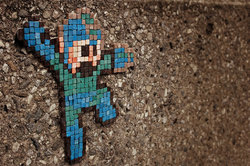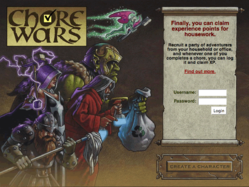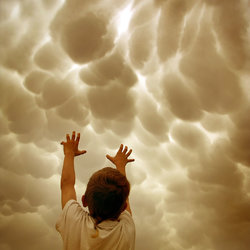
My latest scheme to improve productivity and creative flow: Screw around. Waste time. Make stuff. Banter. Play.
I’m fresh from my first trip to the South by Southwest Interactive Festival, where I did all of those things. I’ve never played so hard for work before. Fire dancers, live music, barbecue, a magic act, battledecks, margaritas at the Austin City Limits studio, stupid-hot tacos, and okay, yeah… five days of mind-bending ideas and a chance to hang with the brightest in the creative tech industry.
So, um, not your usual tech conference. Instead, South by Southwest itself embodied a theme that I traced through lots of the SXSW sessions this year: The power of play to spark passion, forge new ideas, and create new connections. Stuff that looked dangerously like goofing off at SXSW was, on the contrary, inspiring, energizing and entirely productive. I learned as much at the many SXSW parties as I did at the excellent panel sessions.
Folks who work on their own, as I do, tend to grapple with work/life-balance issues; we work either too much or too little. Either way, we beat ourselves up for maintaining a lousy balance between work and play. The answer, I think, is to stop trying to separate the two, to coax work into play. Give yourself permission to screw around and explore.
Sensational side projects
The Chicago design firm Coudal Partners is a great example. It sometimes seems like these guys do anything and everything except design work. They make short films. They organize craft barter exchanges. They launch side businesses. They run an independent ad network. They burn vast amounts of brain cells on clever wordplay, like their game “Booking Bands” (Quick! Mash together a band name and a book title. E.g. “Megadeth of a Salesman,” or my own tepid offering, “For Whom the Belle and Sebastian Tolls”). Some of this stuff generates revenue, but most doesn’t, at least not directly.
In his talk at SXSW, Jim Coudal admitted that this buzz of creative activity is a kind of career-level attention deficit disorder. But it’s the excitement of launching odd little side projects that keeps his crew creatively productive. “That short attention span must not be denied,” he said. “That initial moment of passion, this is the amplification of the creative moment. You want to engender that feeling.…You’re going to do more satisfying and quality work when you’re happy.
“That’s why we do what we do,” he said. “So that we can actually do the work.”
This isn’t play as procrastination, although it might look that way. It’s not about playing solitaire on your PC to dodge work. Friends, this is goofing off as bonafide professional development. By engaging in a regular diet of activities that simply give you pleasure, you hurl yourself into your “regular” work with new energy. Play gives your brain a new set of problems to solve, a dose of delight to jerk you out of your rut and see your work in a new light.
Handily enough, there just happen to be a jillion creative playgrounds springing up everywhere. Any of us can be directors, photographers, authors, t-shirt makers, you name it.”There are a lot of people out there who have an artist inside them and don’t know how to express it,” Derek Powazek said in his SXSW talk about mushrooming creative communities. “You have no excuse anymore for not using the talent you have.”
Or, put another way by Henry Jenkins in his thought-provoking opening remarks at SXSW: “What’s wrong with America that people don’t have the opportunity to express this level of intellect and creativity in the workplace?”
Me, I plan to continue adding little side projects to learn stuff, experiment with fresh techniques, and re-experience the thrill of the new. Diversions? For sure. But these little deviations from the day job help to fuel enthusiasm for my main gig, developing Big Medium. While some of these projects may actually be productive, possibly even related to Big Medium, I hope to see more than a few that are just goofy fun. Y’know, for kids.
“Be interesting”
The gang at 37signals (they happen to share office space with Coudal) are actually institutionalizing this kind of play, as CEO Jason Fried explained in a recent blog entry titled Workplace Experiments:
We decided that 37signals would help people pay for their passions, interests, or other curiosities. We want our people to experience new things, discover new hobbies, and generally be interesting people.
For example, Mark has recently taken up flight lessons. 37signals is helping him pay for those. If someone wants to take cooking lessons, we’ll help pay for those. If someone wants to take a woodworking class, we’ll help pay for that.
Part of the deal is that if 37signals helps you pay, you have to share what you’ve learned with everyone. Not just everyone at 37signals, but everyone who reads our blog. So expect to see some blog posts about these experiences.
“Be interesting people.” What could be more important, not only as creative professionals but as human beings? Very cool that the company not only encourages these side projects but actually underwrites them.
I believe it was the beloved author Jack Torrance who wrote (more than a few times), “All work and no play makes Jack a dull boy.” Ain’t it the truth. Periods of nose-to-the-grindstone work, with long days of nothing but code, tend to leave me listless and, my long-suffering wife will agree, vaguely anti-social. A week or two of crunch mode drains both energy and enthusiasm. Fresh ideas come more slowly; it’s harder to pull myself to the keyboard.
By contrast, a varied mix of extra-curricular activities keeps me charged up. Get out of the office, learn something new, get fresh perspective. New pursuits and little distractions give my work fresh life. As an added bonus, my friends are relieved to discover that I can actually offer more to conversation than what I’m doing to refactor my codebase. (“Refactor? Codebase?”) Stuff that I do when I’m supposed to be working: museum visits, afternoon runs, cooking experiments, writing this blog, matinee screenings of classic films, café downtime with friends, wandering unfamiliar neighborhoods of Paris.
A relentless work ethic dies hard, though. Although the benefits of getting away from my keyboard are obvious and have been demonstrated many times over, guilt lingers. It feels like hooky, which of course it is. For me, at least, it requires discipline to be undisciplined. It’s tough to accept that the best route to a goal isn’t always a straight line, but I’ve found that fresh angles allow for serendipity and new inspiration.

“The beautiful mistake”
Web designer Nazim Hamid gave an engaging talk at SXSW about his work process. Although the talk was titled “Design Is in the Details,” some of Naz’s best material focused instead on escaping the details, pulling back from your work to get fresh perspective. Naz described his own personal strategies for doing this, and three particularly resonated:
Mix and match. “You have this constant desire to fall back on things you’ve done before,” Naz said. To avoid this staleness, experiment with mixing past techniques to generate new hybrids and create something unexpected. “I call this the beautiful mistake.…If it’s not working, open up something else and play with it. Mix and match.”
Take seven days before starting a new design. “You don’t have to start working on it right away,” Naz said. Instead of diving straight into a new project, let it percolate so that you can gradually develop the full idea for the project instead of winging it as you go. “That’s the time when I’m waiting for inspiration to strike,” he said. “And then you know how it is: When you have the idea, you put it down on paper, and it’s done in a day.”
Let the design rest. Before calling a project finished, put it aside so that you can come back to it with fresh eyes and recapture the power of the first impression. “I sometimes take two days off from a design. You know, forget it,” he said. “When you go back, take notes on what jumps back at you.”
I’m going to incorporate these practices into my own work discipline, and we’ll see how it goes. Whether or note these particular tactics work for me (or for you), the worthiness of the goal seems evident: Pull back from your work to find new approaches. Ultimately that means finding surprise and delight in your own work, and why not? If you can no longer delight yourself, how can you expect to delight your customers and colleagues?
I’m reminded of a 1964 documentary interview with Robert Rauschenberg when the artist was asked if he liked to be surprised by his work. “Yes, it wouldn’t work any other way,” he said. “Otherwise, it’s just dry manipulation.” When you’re no longer surprised by your own work, you’re simply in the business of mass production, of factory work. Most of us aspire to something more.
I wrote about how to capture this moment of surprise a while back in Magic Boxes, Canned Chaos and Creative Totems: “The process of creation depends on flashes of inspiration, moments where you manage to leap out of your usual groove and see things from a new perspective. Whatever knowledge and expertise you may bring to your craft, it’s these moments of fleeting mystery that actually manage to kiss your work with an instant of virtuosity.”
As I wrote there, these moments of mystery can be prodded through familiar rituals and escapes; Naz’s rituals fit the bill nicely.
Ingredients of happiness
Play, delight, mystery and surprise. Hell, I’ll take that in a workday. Mix in community, skill, and a job well done, and you have all of the ingredients of happiness. Or so say the researchers.
Jane McGonigal is a game designer who gave a terrific keynote at SXSW about happiness and the role games might play to “embed happiness engines in everyday life,” including our work lives. She noted recent psychology research into the sources of happiness, which apparently boil down to four factors:
- Satisfying work to do
- The experience of being good at something
- Time spent with people you like
- The chance to be part of something bigger
These also happen to be the essential ingredients of our favorite games, and Jane suggested that making our lives more game-like could also make them happier. “Instead of making games more realistic, with better graphics or better [artificial intelligence], I’m trying to make the real world more like games,” she said.
“When I join a game in a virtual world,” she said, “the first thing I have are legions of collaborators and allies who want to help me. Most of us, when you get out of bed, you’re not exactly walking into that same environment.”
Her idea: By introducing game-like systems into our work and home lives, we can imbue otherwise tedious tasks with the spirit of reward and collaboration that makes gameplay fun. Jane pointed to a game called Chore Wars which turns housework into gameplay for families. (“Finally you can get experience points for housework!”) She also pointed to the Nike+iPod gizmo that transforms running into a community video game.
In his talk, Henry Jenkins called for a similar investigation into how we might introduce the compelling mechanisms of video games into education, endowing schools with the characteristics that glue kids to their game consoles: Solving complex problems, learning that it’s not fatal to make a mistake, strong roles, clear goals.

Most of us have figured out how to introduce at least some degree of gameplay into our work. Even the humble checklist is an essential game-like ingredient, a primitive “point system” for tracking success and satisfaction with our own progress. In that vein, productivity geek Merlin Mann comes up with endless game-like ways to fake out your brain and do an end-run around procrastination and constipated work processes (e.g. the procrastination dash, cringe-busting, etc.).
For folks like me who build systems intended to be used in people’s work, the idea of introducing gameplay into the workplace presents both a challenge and an opportunity. As screen interfaces increasingly define our working life, those interfaces logically shape our environment, hopefully for the better. As Jane said, “More and more of us will be in the business of producing happiness engines.” Me, I’ve tried from the get-go to make Big Medium fun to use; I strive to give it a personality, a voice, and flourishes that surprise and delight. But SXSW challenged me to consider how I might make this interaction even more playful and satisfying… more magical.
Uh oh, it’s magic
Usability guru Jared Spool gave an inspired talk at SXSW about what magicians can teach interface designers about the power of illusion: making complexity evaporate, making the mundane delightful. “People want magic in their lives,” Jared said. “It brings a certain level of delight that we don’t see in other places.”
He pointed out that it’s more than efficiency and functionality, though those are crucial, that make an interface a pleasure to use. Mixing in whimsy and playfulness can introduce genuine joy. (Magic tricks sprinkled throughout his talk underscored the point.) Jared pointed to the playful language at Flickr (the “Flickr is having a massage” error message; “Embiggen small photos” in an option dialog), and to Apple’s faithful representation of your iPod’s physical color in iTunes (“They actually used valuable ROM space in the iPod just to communicate the color!” he enthused).

The message: As software designers, we’re solving interface puzzles, not world famine. Lighten up.
A little deviousness helps, too. Like magicians, our role as designers is to make the complex or impossible seem effortless through well-placed misdirection and willful trickery. When you’re using Big Medium, you shouldn’t have to think about what’s happening under the hood or how the software organizes its data. That tedium is my headache, not yours. If I do my job right, adding content to your site should actually be fun; it should make you smile, maybe even scratch your head in a “how’d they do that” moment. Sure, it’s just a content management system – what could be more dry? – but that doesn’t mean that it can’t offer genuine moments of pleasure and even magic. It’s my responsibility not to bore my customers, and it’s my challenge to make their work feel like play.
It’s a theme that the wonderful Kathy Sierra has pushed for years, and she picked up on in it in her SXSW talk, too. She noted the crucial connection of joy and play leading to learning and skill. Making a product fun means that you’re providing incentives to explore its every corner. “Make it all about how the user feels,” she said. “Nobody’s passionate about something they suck at.”
And likewise, it’s all too easy to suck at something you’re not passionate about. For me, the play, camaraderie, and seeming downtime of SXSW made me even more passionate about my work. I’m tickled to put goofy playfulness front and center in my office, my work and my products.





